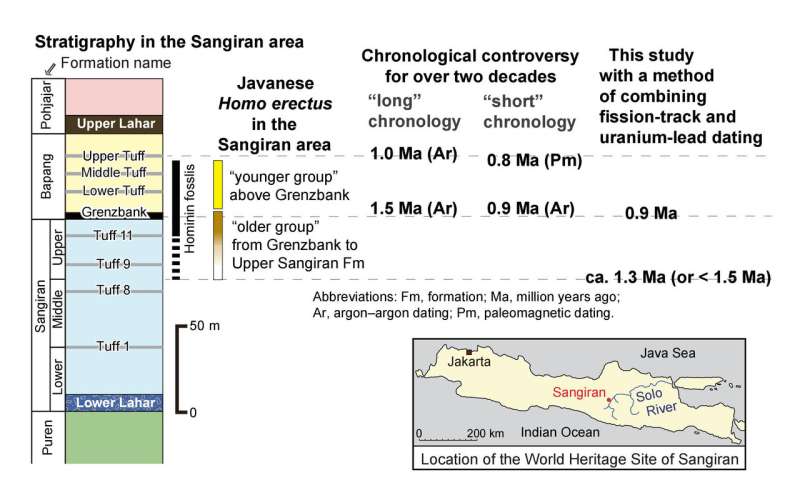The most complete cranium of Javanese Homo erectus so far found. This specimen [Pithecanthropus VIII (Sangiran 17)] dates to ca. 0.82 million years ago and belongs to the chronologically younger group of the Sangiran hominins. Credit: Hisao Baba/National Museum of Nature and Science
A team of researchers from Japan, Indonesia and Germany has found evidence that suggests Homo erectus arrived on the island of Java approximately 300,000 years later than thought. In their paper published in the journal Science, the group describes using two techniques to date the volcanic ash from which the oldest known fossils were unearthed, and what they found.
Back in 1994, archaeologist Carl Swisher dated the same fossils to approximately 1.8 million years ago, a time frame that suggested Homo erectus had emerged as a species in Asia rather than Africa. Since that time, the fossil dates have become controversial in the archaeological community. In this new effort, the researchers sought to settle the debate by carrying out two types of dating to show how long a sample of volcanic ash has been fixed at a site. In this case, the site was the Sangiran dome—an uplifted tectonic dome on the island of Java, in Indonesia. The site has thus far yielded over 100 hominin fossils since it first came under study in 1936.
The two techniques used by the team were uranium-lead dating, which allows for measuring the crystallization age of a volcanic soil sample, and fission track dating, which measures characteristics of zircon grains in the volcanic material spewed during an eruption, and thus, the age of a volcanic eruption. The team used both techniques to test the volcanic material in which the fossils were found. The researchers report that both techniques showed an age of 1.3 to 1.5 million years. This rolls back Swisher's estimates by by approximately 300,000. And more importantly, it suggests that Homo erectus first emerged in Africa and migrated to Asia. This is because prior studies have dated H. erectus fossils in Georgia to 1.8 million years and in China to 1.6 million years.
Figure showing Sangiran location and generalized stratigraphy and outlining the provenance of two chronological groups of the Sangiran hominins, chronological controversy for over two decades, and our results from this study. Credit: Matsu’ura et al., Science (2019)
The researchers suggest that because they used two independent dating techniques that agreed with one another, their results should settle the debate regarding the earliest known time H. erectus lived on Java—and it should also settle the issue of where H. erectus first emerged.
Two mandibles of Homo erectus which date to between ca. 0.90 and 1.1 million years ago. These specimens [left, Pithecanthropus C (Sangiran 9); right, Pithecanthropus F (Sangiran 22)] belong to the chronologically older group of the Sangiran hominins. It is interesting that the mandibles have been reported to display relatively primitive features which are comparable in morphology to hundreds of thousands of years earlier African Homo erectus. Credit: Shuji Matsu’ura/National Museum of Nature and Science
Journal information: Science
© 2020 Science X Network
![The most complete cranium of Javanese Homo erectus so far found. This specimen [Pithecanthropus VIII (Sangiran 17)] dates to ca. 0.82 million years ago and belongs to the chronologically younger group of the Sangiran hominins. Credit: Hisao Baba/National Museum of Nature and Science Dating of volcanic ash at Sangiran shows Homo erectus arrived later than thought](https://scx1.b-cdn.net/csz/news/800a/2020/5e186414e9f51.jpg)

![Two mandibles of Homo erectus which date to between ca. 0.90 and 1.1 million years ago. These specimens [left, Pithecanthropus C (Sangiran 9); right, Pithecanthropus F (Sangiran 22)] belong to the chronologically older group of the Sangiran hominins. It is interesting that the mandibles have been reported to display relatively primitive features which are comparable in morphology to hundreds of thousands of years earlier African Homo erectus. Credit: Shuji Matsu’ura/National Museum of Nature and Science Dating of volcanic ash at Sangiran shows Homo erectus arrived later than thought](https://scx1.b-cdn.net/csz/news/800a/2020/5e18643fce1ba.jpg)























